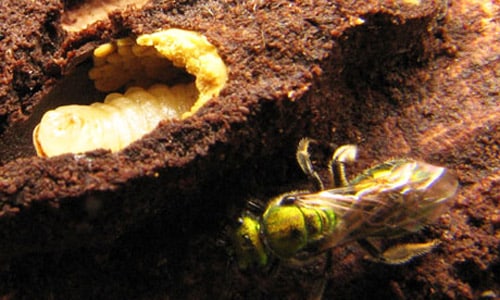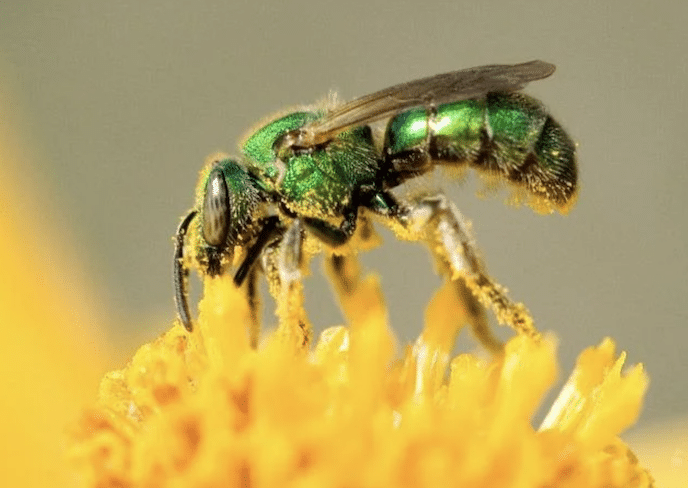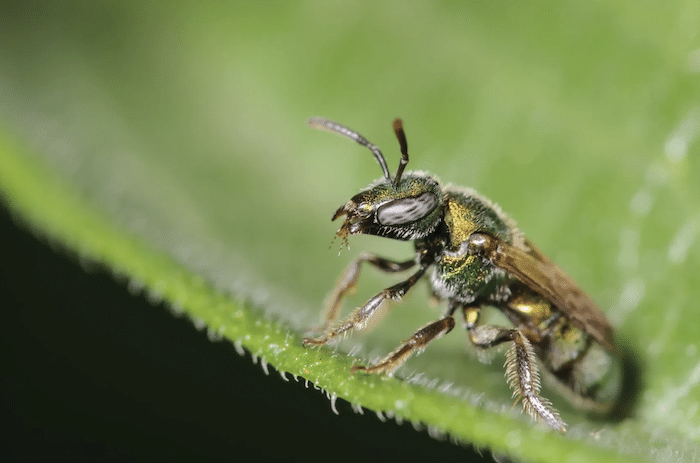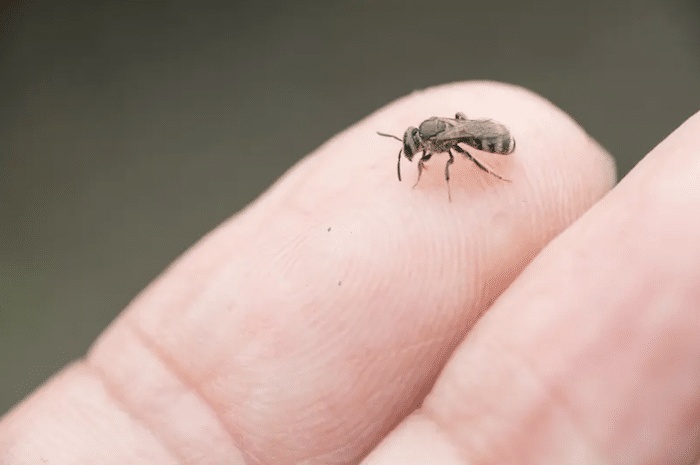Contents:
- What are Sweat Bees?
- 7 Quick Facts about Sweat Bees
- Types of Sweat Bees
- Physical Characteristics of Sweat Bees
- Sweat Bees’ Social Behavior
- Life Cycle of Sweat Bees
- Sweat Bees’ Nesting Behavior and Habitat
- Sweat Bees’ Diet
- Do Sweat Bees Sting?
- FAQs
What Are Sweat Bees?
Sweat bees belong to the Halictidae family, one of six bee families within the order Hymenoptera. Their common name comes from a behavior unique to them: they often land on human arms and legs to consume the salt in our perspiration. They are also called Halictids, in reference their family name.
Halictids are the second largest bee family after Apidae (the family that includes honey bees) and are found in every continent on earth except Antarctica. There are nearly 4,500 species within the Halictidae family; most sources claim that 500 or more species of sweat bees are native to North America. Sweat bees are found in abundance in temperate areas in the U.S. and are diverse in both appearance and social behavior.
Sweat bees are commonly confused with hover flies. Hover flies are also attracted to the salt and minerals in human sweat, and their striped markings mimic those of a bee. However, hover flies are typically hairless and lighter in color than sweat bees. They also have a characteristic abdomen-bobbing behavior, only a single pair of wings, and no stinger.
7 Quick Facts about Sweat Bees
- Sweat bees belong to the family Halictidae, and are the second largest family of bees, after Apidae: the family that includes honey bees.
- Their common name “sweat bee” comes from their attraction to the salt in human perspiration.
- Sweat bees, while most abundant in temperate regions, can be found in almost every environment and are native to every continent except Antarctica.
- Sweat bees are one of the most diverse families of bees in terms of size, coloration and social behavior.
- Sweat bee species can be solitary, communal, semi-social, or (like honey bees) live in eusocial colonies with relatively strict segregation of work and reproductive rolls. Some species even change their social behavior, depending on time of year, elevation and scarcity or abundance of forage.
- Sweat bees are important pollinators of native wildflowers and trees, as well as commercially raised food products such as stone fruits.
- Sweat bees are largely harmless, rarely display aggressive behavior, and will only sting if physically threatened. Sweat bee sting is very mild and is only a cause for concern for people with severe bee sting allergies.
Types of Sweat Bees
The sweat bee family Halictidae is divided into four subfamilies: Halictinae; Nomiinae; Rophitinae; and Nomioidinae.
Halictinae is the largest subfamily, with over 3,500 species. Most are characterized by a strongly curved basil vein in their wings, and many Halictinae species are metallic green. Notable types of Halictidae are:
- Augochlora is known as the green sweat bee. Augochlora are characterized by their bright green, metallic color.
- Megalopta is one of the few bees that can fly at night. Megalopta are characterized by their pale color.
- Lasioglossum include some species that can live in cold conditions and are one of the rare bees to be found in the Arctic. Lasioglossum are small bees characterized by dull metallic bodies.
- Specodes don’t create their own nest, they lay their eggs in other bees’ nests where their larvae consume the food stored there. Specodes are known as “cuckoo bees” because of this behavior. They’re characterized by wasp-shaped bodies, often colored in red or black.
Nomiinae are the second largest subfamily of Halictids, with approximately 600 different species. Many of these are characterized by blue-green metallic bodies and striped abdomens; they are commonly called striped sweat bees.
Rophitinae are characterized by antennae close to their faces. While many sweat bees are generalist foragers, many Rophitinae species have specific floral preferences, specializing in only a few pollen sources.
Nomioidinae is the smallest subfamily in terms of number of species, and most are characterized by their very small size. They’re usually found in dry areas with sandy soil.
To see images of these different sweat bee subfamilies and to learn more about their behavior, visit the beeprofessor’s website.
The Physical Characteristics of Sweat Bees
Most sweat bees are slender and on the small side when compared to honey bees and bumble bees. Three defining characteristics are:
- Short tongues
- Hairless, finger-like appendages found further up the mouth tube than on other bees
- Strongly curved basal veins on their wings
Size and coloration vary considerably by species. They are tiny to medium-sized bees, ranging from 3 to 10 mm (0.1 to 0.4 inches) in length, and are typically slender in form. While most are black or brown in color, some species are metallic green, blue, or purple. Others are striped like honey bees, with bands of green, red or yellow on their abdomens.
Sweat Bees’ Social Behavior
Sweat bee species can be solitary, communal, semi-social, or eusocial. Some solitary species produce lactones, which have a chemical signature unique to each bee. They excrete these lactones in their nests, helping them identify them when they return from foraging. Communal species create nests near each other, where each female tends her own brood, and the proximity of nests helps protect them from predators.
Semi-social and eusocial (the highest form of social organization, with defined roles for work and reproduction; honey bees are eusocial) species have queens and daughter bees. The queens lay the eggs, and the daughter bees tend the nests and forage for food. Some species form small nests, with one queen and several daughter-workers, while others have larger nests, with several queens, hundreds of workers, and may be occupied for years. None of these eusocial species have as rigidly defined roles as honey bees or produce hives with even a tenth the size of honey bees.
Some species of sweat bees change behavior based on altitude, amount of forage, climate or time of year.
The Life Cycle of Sweat Bees
Sweat bees go through four stages of metamorphosis — egg, larva, pupa, and adult — similarly to honey bees. Some species overwinter, staying in their underground nests throughout the cold months. Solitary species will often have several generations in the course of a year, depending on climate.
Some pupae will remain dormant for over a year, acting as a back-up for drought or severe weather years with limited forage.
Semi-social and eusocial species start with a single female laying a number of eggs. When these hatch, grow through the larval stage, pupate and emerge as adults, they become daughter/worker bees, foraging for food and tending the next generation of eggs laid by their mother, who acts as a hive queen. After three generations, the last daughters overwinter and emerge in the spring to lay their own eggs.
Sweat Bees’ Nesting Behavior and Habitat

Most sweat bees are ground nesters, and prefer stable, easily excavated soil, such as clay. This is one reason they are often found on the banks or ponds, streams and rivers. They create waterproof cells, fill the cell with pollen and nectar, lay an egg on top of the food, and seal the cell. They provide their larvae with all the nourishment they will need to develop before emerging as adult bees. This nesting/feeding behavior is called “mass provisioning,” as opposed to “progressive provisioning” — a practice common to honey bees, where worker bees bring food repeatedly to larva as they grow.
A few species of Halictids are kleptoparasitic. They don’t create nests of their own; they lay their eggs in the nests of other bees, and leave their larvae to eat the food stores and eggs of their hosts.
Sweat Bees’ Diet
Given how diverse the family of Halictids is, it’s no surprise that their foraging habits vary considerably from species to species. Some species are specialized foragers, consuming pollen and nectar from only a few plant species — in some cases, they forage from only one type of plant. Most sweat bees, though, are generalist foragers, and will take nourishment wherever they can find it.
On the surface, it seems like a win-win for generalist forager sweat bees and the flowers they pollinate — bees have access to more species, and plants have a variety of species to pollinate them — but plants prefer specialized pollinators, as the pollen gathered from one flower is likely to be deposited on another of the same species, leading to fertilization. When a generalist foraging sweat bee lands on, say, a coneflower, and then moves on to a daisy nearby, the pollen from the coneflower may be deposited on the daisy, where no fertilization can take place.
To stem this wasted pollen and increase the likelihood of fertilization, many flower species have evolved the shape of their flowers and the position of stamens and anthers to attract only pollinators that can access their nectar, and in doing so, be coated in their pollen. Many pollinators have evolved alongside them, through the shape of their bodies or the length of their tongues, to give them access to the nectar and pollen they seek for nourishment.
To counter this plant evolution, generalist foraging sweat bees seem to be adept at learning how to access and manipulate a variety of different flower types; some have evolved the ability to vibrate their bodies, shaking loose pollen onto themselves. This behavior, called buzz pollination (also a behavior of bumble bees), makes these species of sweat bee important pollinators for crops such as blueberries, eggplants, kiwis and tomatoes.
To learn more about the foraging habits of sweat bees and how they’ve adapted to the pollinating strategies of different flowering plants, read this fascinating piece produced by the U.S Forest Service.
The more than 500 species of Halictids in North America are an important source of pollination for a host of native trees, shrubs and flowering plants. They’re also important pollinators of introduced agricultural crops, such as alfalfa, apples, stone fruits, sunflowers, and watermelons.
Do Sweat Bees Sting?

Sweat bees can sting, but their sting is one of the mildest, and for most people will cause only minor, temporary irritation. Sweat bees have mild temperaments and will only sting if physically threatened. If one lands on you, and you are bothered by it, you can gently brush them off, and are unlikely to be stung. You can also sit still for a few moments and they will soon fly away.
Given their low level of toxicity, only those with a severe bee sting allergy should be worried about being stung by a sweat bee. According to WebMD, if you are stung by a bee and have a severe allergy to bee venom, or if you are concerned that you or someone you’re with might be severely allergic, seek medical care immediately. You can learn more about symptoms of allergic reactions here.
FAQs
Q: Why do sweat bees like human sweat?
A: Halictids, commonly known as “sweat bees,” derive salt and needed minerals from human perspiration. Landing on human arms and legs to consume our perspiration is where they get their common name from.
Q: Where are sweat bees found?
A: Sweat bees, while most abundant in temperate areas, can be found in almost every environment, including the arctic. They are found on every continent on earth, except Antarctica. There are more than 500 species of sweat bee native to North America.
Q: What do sweat bees pollinate?
A: There are over 500 different species of sweat bees in North America, with varying foraging behaviors. While most are generalist pollinators, meaning they forage nectar and pollen from a wide variety of flowering plants, some are specialist pollinators, attracted to only a few, or even just one species of plant.
Q: Are sweat bees important pollinators for any agricultural crops?
A: Sweat bees are important pollinators of crops such as alfalfa, apples, stone fruits, sunflowers, and watermelons.
Q: Do sweat bees sting?
A: Sweat bees are not aggressive and will only sting if they are physically threatened. They have one of the mildest stings of any bee and are a danger only to people with severe allergies to bee venom.
Q: If a sweat bee lands on me, what should I do?
A: The best solution is to quietly ignore it — it will drink a small amount of perspiration and then fly away. If you can’t do that, gently brush it off, being careful not to press it against your skin.








